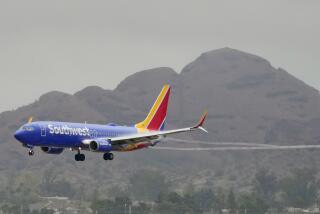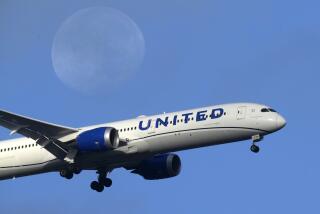Frequent-Flier Programs Hit Stormy Weather
- Share via
There aren’t many airlines left that are really glad to offer frequent-flier incentives.
Some of them won’t admit it, but if they had their druthers they’d drop the programs in an instant. These schemes have become one of the most costly, most controversial, most difficult to administer marketing ploys.
Their underlying weakness is that they haven’t won for the airlines the market share increases that were hoped for.
Remember a few years ago when car-rental companies offered the same kind of deal? Every time you picked up your car you were given three tennis balls or a tote bag, or you could save up your “rewards” to get bigger prizes--sailboats, TV sets and the like.
Twenty minutes after the first plan was introduced, every major car rental company had one in place.
No Market Shift
Result? There was no significant swing in market share--and operators spent millions of dollars needlessly, ostensibly in pursuit of developing “brand loyalty,” but really only to maintain the same positions they held before the expensive giveaway games began.
At least that industry was smart enough to cut a deadline and end the programs.
Afterward Avis, Hertz, National, Alamo, Budget, Dollar and the rest went off to lick their wounds, poorer, but, one assumes, somewhat wiser.
Now airline programs primarily involve upgrades on future flights, discounts on travel and free flights.
Along the way they’ve become involved with other airlines, with hotels and auto rental firms and with cruise lines. Take a cruise and earn mileage credits in United’s plan; rent a car or stay at a specific hotel and pad your American frequent-flier miles total.
That’s the way it works these days. Sometimes you get credit on an airline even when you’re not flying.
The difference between what the car rental companies did and what the airlines have done is that the airlines don’t have a closing date. Their programs are continuing and it’s difficult to see how they can ever stop, assuming they want to.
Getting a new name on the frequent-flier list seems to be what’s really important right now.
Wanted to Upgrade
Take the case of the businessman who recently flew to Los Angeles from Houston on Continental Airlines. At Houston Intercontinental Airport he decided he’d try to upgrade to first-class.
The difference between his regular coach fare and first-class might have been $140 or $150, but he was ready to pay what was required.
“Are you a member of (Continental’s frequent-flier program) OnePass?” the counter agent asked. He admitted he wasn’t.
“Then you can’t upgrade,” she said. “But I can make you a member right now.”
With that, she proceeded to fill out a OnePass form and then upgraded him for $30. He paid her $30, but he believes that might have been the OnePass fee and that the upgrade was free. Free upgrades have become a difficult fact of life for the airlines.
According to some estimates, a full-fare, first-class passenger can provide the airline up to five times the yield provided by a passenger on the lowest discount fare. Nowadays, many flights go out with first-class sections almost filled with travelers who have earned upgrades or whose accumulated mileage has entitled them to free tickets.
Voucher Brokering
All of this free or discounted travel spawned a new industry--frequent-flier voucher brokering. A raft of companies opened, buying vouchers from customers and reselling them to the general public at below tariff.
The airlines tolerated it until the number of companies involved became too big and until the amount of money changing hands began to reach hundreds of millions. Then they moved forcibly to cut off the supply.
They went to court and had a couple of coupon brokers put out of business. And there will be others.
Airline frequent-flier programs have become cooperative ventures in many cases. Airline A joins Airline B in a common rewards plan; customers earn mileage credits for travel on either one.
Unfortunately, it doesn’t always work all that smoothly, as the recent celebrated dispute between Pan Am and American reminds us. The two merged their programs (Pan Am’s WorldPass and American’s AAdvantage) in the hope that they could be mutually supportive of one another. Within a year American sued Pan Am for more than $4 million that it claimed it was owed. Pan Am disagreed and pulled out, taking WorldPass with it.
Programs Vary
Airlines that take over other airlines find themselves in trouble trying to reconcile the reward levels of one frequent-flier program with the other. One airline might give upgrades at 20,000 miles and the other at 40,000.
What does the merged carrier offer? Western had one of the more generous programs and Delta had a little difficulty integrating its program with Western’s after the takeover this spring.
Things have reached such a sorry pass that we have Continental and United trying to raid one another’s frequent-flier base in the fiercely competitive Denver area.
There, recently, United personnel were told to seek out Continental passengers and try to persuade them to switch carriers. It was known as the Try Our Real Quality United Experience program, or TORQUE.
Carrier Got Angry
It probably didn’t create much of a market-share shift but it did get Continental mad. That carrier then announced that it would offer passengers full credit for all miles earned so far on United’s Mileage Plus plan if they would join OnePass, and would credit them with quadruple miles for all Continental flights flown through Dec. 15.
United’s response (TORQUE 2? Son of TORQUE?) is awaited.
John Power, senior marketing vice president of British Airways, said recently that if frequent-flier programs were to be banned overnight, his company would lead the cheering. Other airline executives may not be so open about their attitudes, but privately they share Power’s view.
But frequent-flier programs won’t be banned overnight. The airlines, to their regret, are stuck with them.
More to Read
Sign up for The Wild
We’ll help you find the best places to hike, bike and run, as well as the perfect silent spots for meditation and yoga.
You may occasionally receive promotional content from the Los Angeles Times.






